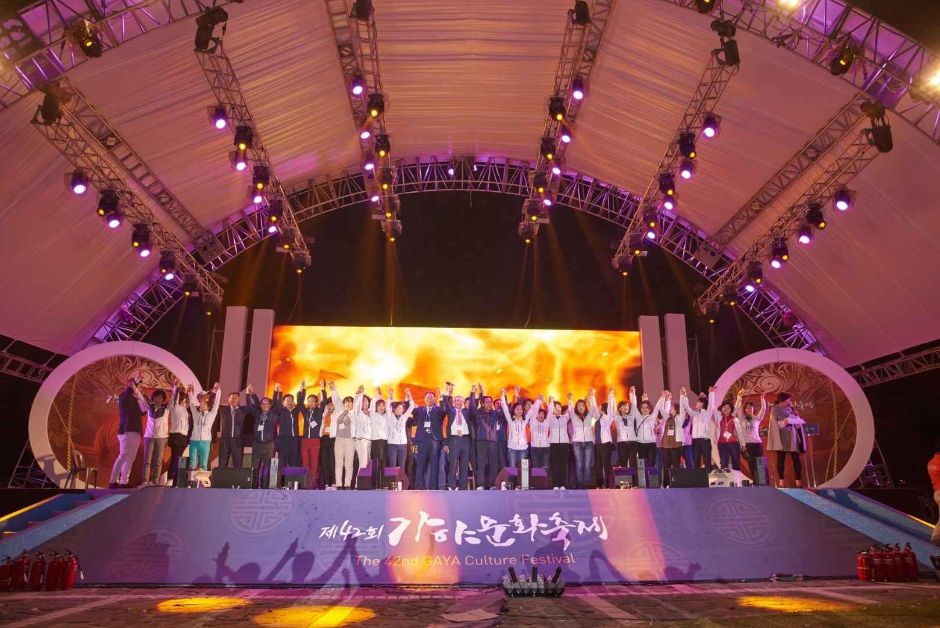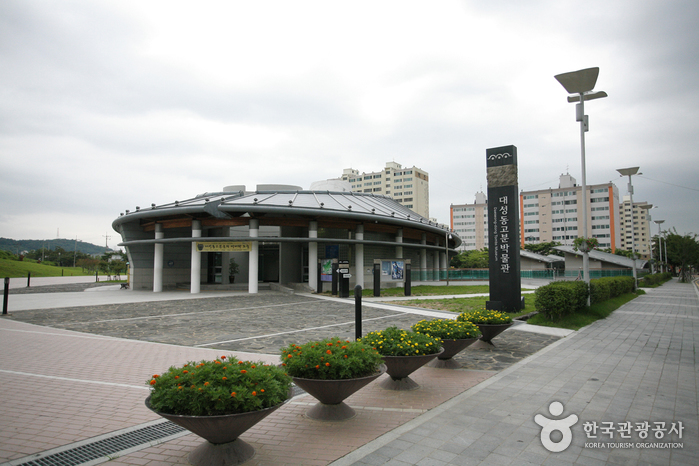Uniqlo - Shinsegae Gimhae Branch [Tax Refund Shop] (유니클로 신세계김해)
19.3Km 2024-04-23
2232, Gimhae-daero, Gimhae-si, Gyeongsangnam-do
-
Galaxy - Shinsegae Department Store Gimhae Branch [Tax Refund Shop] (갤럭시 신세계백화점 김해점)
19.3Km 2024-04-18
2232, Gimhae-daero, Gimhae-si, Gyeongsangnam-do
-
Shinsegae Department Store - Gimhae Branch [Tax Refund Shop] (신세계백화점 김해)
19.3Km 2024-04-23
2F Lotte Outlet Gwanggyo Branch, 10, Docheong-ro, Yeongtong-gu, Suwon-si, Gyeonggi-do
-
E-Mart - Gimhae Branch [Tax Refund Shop] (이마트 김해점)
19.3Km 2024-04-23
2F, 10, Docheong-ro, Yeongtong-gu, Suwon-si, Gyeonggi-do
-
Gaya Culture Festival (가야문화축제)
19.4Km 2024-10-08
35 Bunseong-ro 261beon-gil, Gimhae-si, Gyeongsangnam-do
+82-55-330-6840
The Gaya Culture Festival celebrates the Gaya Kingdom, founded by King Kim Suro in AD 42, and its 500-year history. Gaya was quite advanced in the production of earthenware and iron implements, evidenced by the many artifacts found from that time. Through the Gaya Culture Festival, the region is continuing to preserve, build on, and develop the Gaya culture and heritage. The Gaya Culture Festival asserts Gaya’s rightful place alongside the Goguryeo, Baekje, and Silla kingdoms.
Gimhae Astronomical Observatory (김해천문대)
19.5Km 2022-12-29
254, Gaya thema-gil, Gimhae-si, Gyeongsangnam-do
+82-55-337-3785
Gimhae Astronomical Observatory opened on February 1, 2002 as part of the Millennium Commemorative Project that started in December 1998. It was built to satisfy the general public’s curiosity about the universe and celestial bodies, inspire young people, and give everyone a unique, memorable experience. The observatory is shaped like an egg, in memory of the legend of King Kim Suro, the founder of the Garak Kingdom, according to which the king was born from an egg.
It is said that the queen of King Suro, Heo Hwang-ok, was a princess from the Indian country of Ayuta. Since sophisticated navigation equipment had yet to be invented, it can be assumed that she found her way to the Garak Kingdom by following the stars. It is also said that a prince of the Garak Kingdom built an observatory on the highest point of a mud fortress in Jinrye in order to make astronomical observations. The place is still referred to as Bibidan, which means a place to watch the stars.
These historical facts indicate the stars were very important to the Gaya, an ancient kingdom established mainly in the Gimhae area. The peak of Bunseongsan Mountain, where the observatory is located, offers sweeping views of the entire area of Gimhae. The night sky of Gimhae offers a breathtaking sight.
Woljeon Fish Market (월전 활어판매장)
19.6Km 2024-02-26
154-21 Jukseong-ri, Gijang-eup, Gijang-gun, Busan
Woljeon Fish Market is a hub of stores specializing in raw fish and seafood freshly caught off the Gijang coast. This destination is ideal for those looking to purchase sea eels, sliced raw fish, and various seafood. Visitors have the unique opportunity to buy these items from the stores and then savor them at a nearby restaurant for an additional service charge. Notably, Woljeon Fish Market is renowned for offering some of the freshest conger eel in Busan. The stores are managed by fishermen themselves, ensuring that customers have access to fresh seafood at affordable prices.
Blackup Coffee (블랙업커피 양산)
19.6Km 2024-03-27
11 Mulgeumyeok 1-gil, Mulgeum-eup, Yangsan-si, Gyeongsangnam-do
Blackup Coffee, a café with a stunning view of the Nakdonggang River, is known for its signature Haesuyeom coffee (sea salt coffee), a unique blend enriched with natural sea salt and homemade fresh cream. This café has risen to fame for its exceptional coffee taste, a testament to their meticulous roasting process that highlights the qualities of premium beans. Additionally, Blackup Coffee also offers classes for customers interested in learning latte art and pour-over brewing techniques.
Museum of the ancient tombs in Daseong-dong (대성동고분박물관)
19.6Km 2023-01-02
126, Gayaui-gil, Gimhae-si, Gyeongsangnam-do
+82-55-350-0401
The Museum of the ancient tombs in Daseong-dong displays artifacts unearthed from the four excavations of the Daeseongdong Tumuli. Highlighting often overlooked relics of the Geumgwan Gaya, the museum has three ground-floor exhibit halls and several underground auxiliary facilities. The main exhibits include a life-sized statue of a mounted soldier and a warrior statue, both recreated based on bones excavated from the tumuli of Yean-ri. The museum relies heavily on videos and dioramas to help visitors explore all the museum has to offer.
Ancient Tombs in Daeseong-dong, Gimhae (김해 대성동 고분군)
19.7Km 2020-04-02
126, Gayaui-gil, Gimhae-si, Gyeongsangnam-do
+82-55-330-3934
The tumuli in Daeseong-dong, located to the east of the Royal Tomb of Kim Suro, reflect the formation and development of the Gaya Era. The Daeseong-dong Tumuli are located in the center of the shell mounds of Hoehyeon-ri, the location of the founding of the Gaya Kingdom according to local legend.
The tumuli relics were excavated by researchers from the Kyungsung University Museum from 1990 to 1992 and were found to be the common burial ground of the dominant class of the Gaya Kingdom. On the hilltops, which were viewed as prime burial places, are the tombs of kings and rulers; on the slopes are the tombs of the lower classes.
A total of 136 tumuli were found in the Daesong-dong area. Further investigation of the tumuli revealed several important and interesting facts. First, from the end of the third century, men and horses were buried alive along with the dead. Also, weapons were bent and buried as well, with many of these artifacts being unearthed among the tumuli. Other materials found in the tumuli such as cylindrical bronze items, pinwheel-shaped bronze items, and jasper items showed that Gaya was involved in trade with Japan. The Daeseong-dong Tumuli is significant in that it gives a glimpse into the political and social structure of the Gaya Kingdom, and the cultural exchange between Korea, China, and Japan.
![Uniqlo - Shinsegae Gimhae Branch [Tax Refund Shop] (유니클로 신세계김해)](http://tong.visitkorea.or.kr/cms/resource/34/2885934_image2_1.jpg)
![Galaxy - Shinsegae Department Store Gimhae Branch [Tax Refund Shop] (갤럭시 신세계백화점 김해점)](http://tong.visitkorea.or.kr/cms/resource/38/2885938_image2_1.jpg)
![Shinsegae Department Store - Gimhae Branch [Tax Refund Shop] (신세계백화점 김해)](http://tong.visitkorea.or.kr/cms/resource/62/2885962_image2_1.jpg)
![E-Mart - Gimhae Branch [Tax Refund Shop] (이마트 김해점)](http://tong.visitkorea.or.kr/cms/resource/33/2885933_image2_1.jpg)



 English
English
 한국어
한국어 日本語
日本語 中文(简体)
中文(简体) Deutsch
Deutsch Français
Français Español
Español Русский
Русский